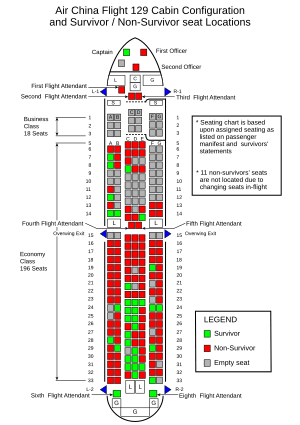Air China Flight 129 facts for kids

The aircraft involved in the accident in 1997
|
|
| Accident summary | |
|---|---|
| Date | April 15, 2002 |
| Summary | Controlled flight into terrain due to pilot error and ATC error |
| Place | Mount Dotdae, Busan, South Korea |
| Passengers | 155 |
| Crew | 11 |
| Injuries (non-fatal) | 37 |
| Fatalities | 129 |
| Survivors | 37 |
| Aircraft type | Boeing 767-2J6ER |
| Airline/user | Air China |
| Registration | B-2552 |
| Flew from | Beijing International Airport, Beijing, China |
| Flying to | Gimhae International Airport, Busan, South Korea |
Air China Flight 129 was a regular international flight. It flew from Beijing, China, to Busan, South Korea. On April 15, 2002, the airplane flying this route crashed. It was a Boeing 767-2J6ER. The crash happened while the pilots were trying to land at Busan-Gimhae International Airport.
Out of 166 people on the plane, 129 sadly died. Investigators later found that mistakes made by the pilots caused the crash. This accident was the first time an Air China crash killed people. It was also the worst plane crash in South Korea's history.
Contents
The Flight and Crash
What Happened on April 15, 2002?
Air China Flight 129 took off from Beijing, China. Its destination was Busan, South Korea. The flight was mostly normal until it got close to Busan. The weather in Busan was bad. There was heavy rain and fog. This made it hard for the pilots to see.
The pilots were trying to land at Gimhae International Airport. They were told to make a special turn. This turn is called a "circle-to-land" approach. It means the plane flies past the runway, then turns around to land from the opposite direction.
The Critical Turn
During this turn, the plane flew too low. It also turned too late. The pilots lost sight of the runway. They should have stopped the landing attempt. Instead, they kept going. The plane then hit a mountain called Mount Dotdae. This mountain was near the airport.
Why Did the Crash Happen?
Investigators looked closely at what caused the crash. They found several reasons.
- Pilot Error: The main reason was mistakes made by the pilots.
- They did not follow the correct landing procedures.
- They flew too low and turned too late.
- They did not stop the landing when they lost sight of the runway.
- They also did not communicate well with each other.
- Air Traffic Control Error: The air traffic controllers also made some mistakes.
- They did not give clear instructions to the pilots.
- They did not warn the pilots when the plane was too low.
- Weather Conditions: The bad weather, like heavy rain and fog, made things more difficult. It reduced visibility for the pilots.
The crash was a very sad event. It showed how important it is for pilots and air traffic controllers to work perfectly together. It also showed the need for clear rules and training.
After the Crash
The Investigation
After the accident, a team of experts investigated. They looked at the flight recorders. These are like "black boxes" that record flight data and cockpit voices. They also studied the wreckage. Their goal was to find out exactly what went wrong.
The investigation took a long time. The final report explained all the factors. It highlighted the errors made by the flight crew. It also pointed out issues with air traffic control.
Changes Made After the Accident
This crash led to important changes. Airlines and airports learned from it.
- Pilot training was improved.
- Rules for landing in bad weather became stricter.
- Communication between pilots and air traffic control was reviewed.
These changes aimed to prevent similar accidents in the future. The safety of flying is always the top priority.
See also
 In Spanish: Vuelo 129 de Air China para niños
In Spanish: Vuelo 129 de Air China para niños


